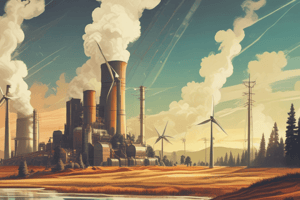Podcast
Questions and Answers
What is a major challenge in using algae as a feedstock for energy production?
What is a major challenge in using algae as a feedstock for energy production?
- Algae absorption of carbon dioxide is low.
- Algae harvesting depletes water resources.
- Algae production requires massive storage units.
- Algae processing is expensive. (correct)
What is a logistical challenge in using wood pellets as a feedstock?
What is a logistical challenge in using wood pellets as a feedstock?
- Wood pellets are difficult to transport.
- Wood pellets produce high greenhouse gas emissions.
- Wood pellets compete with food crops for arable land.
- Wood pellets require massive storage units. (correct)
What is a concern related to the sustainability of biomass energy harvesting?
What is a concern related to the sustainability of biomass energy harvesting?
- Replanting guarantees a complete carbon offset.
- Old-growth trees do not sequester carbon dioxide.
- Clearing forests faster than they can regrow depletes resource availability. (correct)
- Young trees absorb carbon dioxide more efficiently.
What is a consequence of dedicating large tracts of land to energy crop production?
What is a consequence of dedicating large tracts of land to energy crop production?
What is a challenge in using imported feedstocks?
What is a challenge in using imported feedstocks?
What is a characteristic of some energy crops?
What is a characteristic of some energy crops?
What is a consequence of not managing biomass energy harvesting sustainably?
What is a consequence of not managing biomass energy harvesting sustainably?
Why is replanting forests not a guarantee of complete carbon offset?
Why is replanting forests not a guarantee of complete carbon offset?
What is a characteristic of old-growth trees?
What is a characteristic of old-growth trees?
What is a challenge related to the use of forestry products?
What is a challenge related to the use of forestry products?
Flashcards are hidden until you start studying
Study Notes
What is Biomass Energy?
- Biomass energy comes from organic materials like sugar cane, wood, animal waste, grasses, food crops, and algae.
- These sources are called biomass feedstocks.
- Soy and corn are common energy crops grown specifically for use in fuels.
- Fuels made with biomass derivatives are called biofuels.
- Organic industrial waste is another critical source of biomass energy.
Biomass Energy Sources
- Wood processing waste, like sawdust, wood chips, and discarded lumber, can be burned directly or converted into other energy sources.
- Algae is a promising biomass energy source because it grows and produces energy rapidly.
- Algae require less space than other feedstocks and do not monopolize arable land that farmers could otherwise use to grow food.
Converting Biomass to Energy
- The simplest and most common way to convert biomass to energy is burning, like when burning logs in a woodstove or fireplace.
- Gasification combines a set amount of oxygen with a biomass feedstock and heats it to 1,300 degrees Fahrenheit (700 degrees Celsius).
- Co-firing is the synchronous burning of biomass and a fossil fuel, usually coal.
- Fermentation uses microbes like yeast and bacteria to decompose sugars into carbon dioxide and ethanol.
- Pyrolysis involves heating biomass in the absence of oxygen to decompose molecules without combustion.
Biomass Energy Pros and Cons
- Biomass energy has characteristics that make it a solid alternative energy source.
- Carbon neutrality: Biomass energy is potentially carbon neutral because feedstock regrowth absorbs as much carbon dioxide as biomass energy releases.
- Abundance: Biomass energy comes from abundant sources, such as algae, corn, soybeans, trees, and timber waste.
- Renewability: Unlike fossil fuels, biomass energy sources quickly renew themselves as crops and trees continue to grow.
- Cons of biomass energy include initial costs, transportation and storage difficulties, crop competition, and sustainability concerns.
Studying That Suits You
Use AI to generate personalized quizzes and flashcards to suit your learning preferences.




